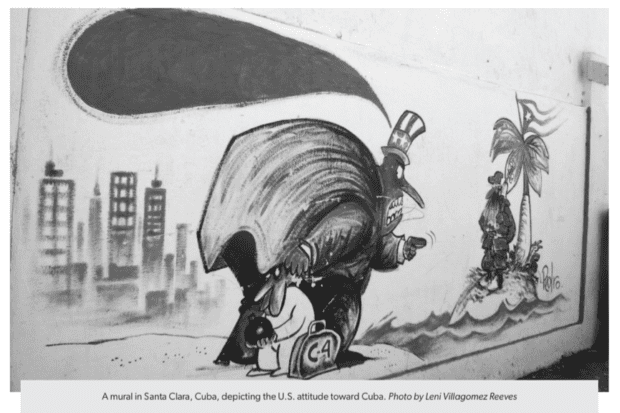
During the crime spree that marked Trump’s last months in office, in between soliciting election fraud and encouraging violence and insurrection to prevent a legal transfer of power, Trump placed Cuba on the U.S. State Sponsors of Terrorism list. This adds to the difficulties for trade, financing and transactions already created by the U.S. blockade of Cuba.
The intent is to cause an economic collapse of Cuba. This is an act of war according to international law, which the United States routinely flouts, along with world opinion, which is overwhelmingly against these measures, as demonstrated yet again in last November’s UN vote in which 182 countries voted against the blockade and only the United States and Israel voted in favor.
There’s no evidence that Cuba has planned, supported, carried out or sponsored any acts of terrorism. The United States, on the other hand, clearly has planned, supported, carried out and sponsored many acts of terrorism against Cuba.
U.S. Anti-Cuba Terrorism
Too bad that the United States doesn’t maintain a list of “States that are victims of U.S.-sponsored terrorism.” Cuba would be in first place.
Most people have heard of the Bay of Pigs, which is called Playa Girón in Cuba. Sixty-two years ago in April, the United States attempted an invasion of Cuba; the attack on April 17 was by troops recruited, trained, armed and transported by the United States. The invasion was preceded (and followed) by numerous acts of terrorism, most notably when U.S. planes with fake Cuban Armed Forces markings bombed three airports.
Some might also remember Omega 7 and Eduardo Arocena, one of the only U.S.-sponsored anti-Cuba terrorists actually convicted of his crimes. He was convicted on 25 charges, which included murders and bombings.
Arocena might have gotten away with these violations if he had confined his crimes to the murder of Félix García Rodríguez, attaché of the Cuban diplomatic mission to the United Nations; bombing the Mexican consulates in New York and Miami; bombing the Venezuelan Consulate in New York City; and ordering Omega 7 partner Pedro Remon to kill Eulalio José Negrín, for the “crime” of negotiating with Cuba about an exchange of prisoners—Remon shot Negrín with a submachine gun, killing him in front of his 13-year-old son.
But Arocena also was responsible for a series of bombings in the New York area that injured bystanders and damaged homes, businesses and a church. The bombed sites included Avery Fisher Hall, Madison Square Garden, JFK Airport, the ticket office of Aeroflot and the Cuban Mission to the United Nations, so the FBI decided it had to do something.
In 1984, before the Federal Court in New York City, Arocena confessed: “The mission of the group headed by me was to obtain certain germs and introduce them into Cuba.”
This was the hemorrhagic dengue fever epidemic that broke out at the end of May 1981 and affected some 344,203 people, causing the deaths of 158 people, including 101 children. At the peak of the epidemic, in early July, more than 10,000 cases per day were being reported. More than a third of the reported victims required hospitalization.
Arocena has stated that the CIA trained him in 1967 in bomb making and a variety of other warfare skills and tactics.
He was sentenced to consecutive sentences of life imprisonment and 35 years’ imprisonment, but he was released in 2021, after 39 years.
In a recent speech to the United Nations, Cuban Foreign Minister Bruno Rodriguez Parrilla stated that “Cuba has been the victim of terrorist actions organized, financed and executed by the U.S. government or from U.S. territory, which has cost the lives of 3,478 Cubans and disabled 2,099.”
Biological Warfare to Kill People
Other terrorist actions against Cuba have included biological warfare. Biological warfare research has been described as “public health in reverse.” Certainly, Cuba has become known for excellent public health and medical internationalism. The United States has been more obsessed with the reverse.
Riley D. Housewright was a U.S. microbiologist who conducted research on biological warfare. He was appointed to Fort Detrick, the epicenter of biological warfare research, in the mid-1940s and became head of the Fort Detrick U.S. Biological Warfare Laboratory in 1956. He worked with the Pentagon to develop biological warfare agents for use against Cuba.
In the early 1960s, under Housewright’s direction, the scientists at Fort Detrick developed a mix of Coxiella burnetii, the causative agent of Q fever; Venezuelan equine encephalitis virus; and staphylococcal enterotoxin B. This mixture of microorganisms and toxins was intended to kill lots of Cubans with little risk to American troops, who presumably would be invading Cuba, as these are relatively non-transmissible from person to person.
It was projected that this bioweapon would kill up to one percent of Cuba’s population, which represents about 100,000 people. Thousands of gallons of this agent were produced at the Pine Bluff Arsenal, a biological agent plant intended to produce standardized biological warfare agents, first established in 1953.
All this was absolutely mainstream U.S. science; it was not seen as ethically dubious or morally or professionally questionable. In fact, when Housewright retired from Fort Detrick he became president of the American Society for Microbiology and a National Institute of Health Fellow.
Biological Warfare Version of Operation Paperclip
The Fort Detrick U.S. Biological Warfare Laboratory has an interesting history. Unit 731 was a covert biological and chemical warfare research-and-development unit of the Imperial Japanese Army that engaged in lethal human experimentation and biological weapons development in China during the Japanese invasion and World War II, with its main base in northern China. The unit is estimated to have killed 200,000–300,000 people.
While Unit 731 researchers arrested by Soviet forces were tried at the December 1949 Khabarovsk war crime trials, those captured by the United States were secretly given immunity in exchange for the data gathered during their human experiments. The United States covered up human experimentation and gave stipends to the perpetrators.
The Americans co-opted the researchers’ bioweapons information and experience for use in their own biological warfare program, just as was done with Nazi German researchers in Operation Paperclip.
Biological Warfare, Offense versus Defense?
After biological weapons research was supposedly discontinued by Nixon in 1969–1972, Fort Detrick converted to “biowarfare defense projects.” Many experts have pointed out that there is an extremely fine line between the two.
Both might include enhancing the virulence of pathogens and investigating optimal techniques to spread them through the air. Offensive research is distinguished from defensive only in intent rather than in reality.
The UN Biological Weapons Convention (BWC; which only bans offensive research) entered into force in 1975. The BWC lacked and continues to lack a mechanism for verifying compliance, which the United States opposes on the grounds that a binding inspection provision could breach the intellectual property of the biotechnology industry. In other words, the United States still does biological warfare research and development.
Biological Warfare Against Food Sources
Another key actor in the U.S. war against Cuba has been Plum Island/Lab 257, established by the U.S. Army, then transferred to the Department of Agriculture in 1954 and to the Department of Homeland Security in 2002, and currently becoming part of the National Bio and Agro-Defense Facility being built in Manhattan, Kan.
This facility was designed to conduct biological warfare against people indirectly, by attacking their food. Biological warfare against food plants and animals was meant to be used to starve civilian populations and force a country to submit.
One example of this warfare mode emerged when anti-Cuban operatives with CIA backing introduced African swine fever virus into Cuba in 1971. A U.S. intelligence source told the media (Newsday) that he was given the virus in a sealed unmarked container at Fort Gulick, a U.S. Army base and CIA training facility in the Panama Canal Zone, and instructed to deliver it to a counter-revolutionary group, which stated they received it and transported it to Cuba.
The virus spread rapidly in Cuba, and half a million pigs had to be slaughtered and destroyed to control the epidemic. This is the only occasion in which this virus has been found in the Western Hemisphere. The UN Food and Agriculture Organization called this epidemic “the most alarming event of 1971.”
Many other attacks on the Cuban food supply have been documented, including multiple biological attacks on the sugarcane crops, on citrus trees, on cattle, on poultry, on bees, on tobacco and on bananas.
Citrus trees in particular have been killed in huge numbers by various agents, and infectious agents persist so that attempts to replant trees have been futile. In 1995, a visiting U.S. scientist was discovered to be carrying vials of citrus tristeza virus in his camera case instead of a camera.
This is a huge lethal-to-trees RNA virus of the Closterovirus genus that is vectored through thrips and has led to the death of millions of citrus trees all over the world. It was intentionally introduced to the island of Cuba.
Bombing of Cubana Flight 455
Some of the terrorist actions organized by the United States against Cuba have been much more direct: bombings and killings. Remember Omega 7 and their bombs and murders? In 1976, they joined with other anti-Cuban groups such as Alpha 66 to form CORU.
For three months before the bombing of Flight 455, CORU waged a campaign of violence against Caribbean countries that had established links with Cuba. In July 1977, they tried to bomb a flight in Jamaica with a suitcase bomb that exploded shortly before it was loaded onto the plane.
Other bombings in the summer included a number of offices of airlines doing business with Cuba. Killings included the murder of a Cuban official in Mexico and two in Argentina; the assassination of Orlando Letelier in Washington, D.C.; and an arson attack in Guyana.
On Oct. 6, 1976, they bombed Cubana Flight 455 killing all 78 souls on board, including 24 children, members of the Cuban youth fencing team returning from winning the gold medals at the Central American and Caribbean Championships in Barbados. Two time bombs were used.
Several CIA-linked Cuban exiles were implicated by the evidence, and CIA documents released in 2005 indicate that the agency “had concrete advance intelligence, as early as June 1976, on plans by Cuban exile terrorist groups to bomb a Cubana airliner.”
Bush Pardons the Terrorist Posada Carriles
Hours after the Cubana Flight 455 explosion, Trinidad authorities arrested Freddy Lugo and Hernan Ricardo Lozano, two Venezuelan men who had boarded the plane in Trinidad and checked their baggage to Cuba, but who had exited the plane in Barbados and flown back to Trinidad.
Lugo and Lozano confessed and declared that they were acting under the orders of Luis Posada Carriles, a CIA operative. Their testimony, along with other evidence, implicated Posada and fellow CIA operative Orlando Bosch, an anti-Castro Cuban living in Venezuela.
The case was tried in Venezuela; Lugo and Lozano were each sentenced to 20 years, and Bosch did 11 years in prison. And Posada Carriles? He bribed prison authorities to allow his escape and fled to the United States, where George W. Bush granted him a full pardon.

